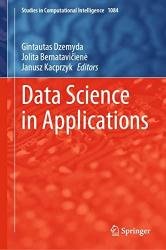Data Science in Applications
- Добавил: literator
- Дата: 11-03-2023, 16:16
- Комментариев: 0
 Название: Data Science in Applications
Название: Data Science in ApplicationsАвтор: Gintautas Dzemyda, Jolita Bernataviciene, Janusz Kacprzyk
Издательство: Springer
Серия: Studies in Computational Intelligence
Год: 2023
Страниц: 250
Язык: английский
Формат: pdf (true)
Размер: 10.2 MB
This book provides an overview of a wide range of relevant applications and reveals how to solve them. Many of the latest applications in finance, technology, education, medicine and other important and relevant fields are data-driven. The volumes of data are enormous. Specific methods need to be developed or adapted to solve a particular problem. It illustrates Data Science in applications. These applications have in common the discovery of knowledge in data and the use of this knowledge to make real decisions. The set of examples presented serves as a recipe book for their direct application to similar problems or as a guide for the development of new, more sophisticated approaches. The intended readership is data scientists looking for appropriate solutions to their problems. In addition, the examples provided serves as material for lectures at universities.
Data Science, a rapidly developing discipline of science and technology, has made a remarkable progress to deal in an effective and efficient way with all kinds of those data related challenges and problems. However, there still are many open questions to be solved, both from analytic and logarithmic points of views, and with respect to implementations. This is an important reason for much research efforts in this and related fields that we witness world wide. To just give some examples, these concern the topics like visualizations, statistics, pattern recognition, neurocomputing, image analysis, Machine Learning, Artificial Intelligence, databases and data processing, data mining, Big Data analytics, knowledge discovery in databases, etc.
Important relations to new developments like block chaining, cyber-social and cyber-physical systems, Internet of things (IoT), social computing, cognitive computing, high-performance computing, cloud computing, crowdsource analysis, etc. are just some examples of what is a current trend. Of course, much research is also done in more traditional fields exemplified by the use of optimization and metaheuristics, information theoretic analyses, etc. to just mention a few. Potential fields of applications of these modern data science-based approaches, and tools and techniques, are too numerous to be listed, they cover practically all areas of science and technology. This growing demand for data science specialists and data analysts implies a considerable growth in new study programs at virtually all universities, and a growing popularity of research on education processes and their effectiveness and efficiency.
This book contains 11 chapters by well-known researchers working in different fields of the broadly perceived data science, involving both more basic and foundational works and relevant applications.
The chapter “The Paradigm of an Explainable Artificial Intelligence (XAI) and Data Science (DS)-Based Decision Support System (DSS)” are concerned with some relevant issues related to the decision support systems (DSS) which are gaining popularity as the explainable artificial intelligence (XAI) is considered to be more and more crucial. Unfortunately, most of the DSSs currently employed are mainly meant for some kind of diagnostics and do not provide mechanisms for more sophisticated solutions. The author proposes to use for this purpose the latest XAI techniques based on the use of a new, generalized approach, the newly developed fuzzy SWOT maps (FSM), and elements of the computing with words (CWW) to deal with lists of rules (LoR).
The chapter “Stock Portfolio Risk-Return Ratio Optimisation Using Grey Wolf Model” propose a risk-return ratio optimization model for stock portfolio that makes it possible to screen the adequate equities for inclusion into the investment portfolio and set its capital allocation ratio. A two-stage model is proposed in which, first, the selection of the initial set of equities is done by using the Self-Organizing Maps (SOMs) to identify a set of the most influential factors to be used as the input variables for the SOM, and second, to find the weight-based ratios for the capital to be distributed among the portfolio equities. The author used the nature-inspired Grey Wolf Optimization (GWO) metaheuristic. Tests are performed on a set from the S&P500 companies. The new model outperforms the traditional approaches.
The chapter “Toward Seamless Execution of Deep Learning Application on Heterogeneous HPC Systems”) are concerned with deep learning for extremely large data or very complex neural network architectures. This implies a need for the parallelization of deep learning algorithms and frameworks, and a need for the use of high-performance computing (HPC). The authors demonstrate methodologies for applying deep learning on HPC and present how AI techniques can successfully be integrated with classical simulation codes, as well as they show a comprehensive and critical overview of training neural networks on HPC while successfully leveraging data, model, pipeline, and hybrid types of parallelism. The applications are shown for combining a multi-task neural network with a typical FEM simulation to determine material characteristics, and for the segmentation of high-resolution satellite images.
Скачать Data Science in Applications
[related-news] [/related-news]
Внимание
Уважаемый посетитель, Вы зашли на сайт как незарегистрированный пользователь.
Мы рекомендуем Вам зарегистрироваться либо войти на сайт под своим именем.
Уважаемый посетитель, Вы зашли на сайт как незарегистрированный пользователь.
Мы рекомендуем Вам зарегистрироваться либо войти на сайт под своим именем.
